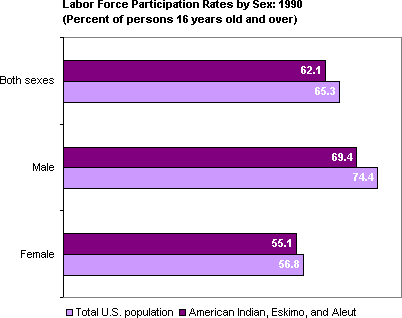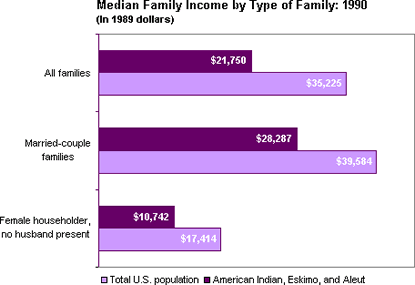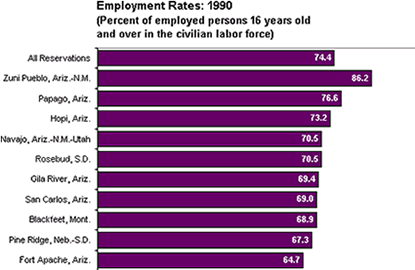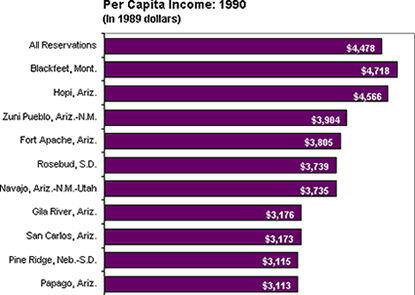To offer you context for our articles about economic development on Indian reservations, we are reprinting selected discussions and charts from We, the First Americans, a publication of the U.S. Bureau of the Census. While these statistics are from the 1990 census, they still offer a picture of how economic life for American Indians on reservations compares with that of the rest of the U.S. population.
Charts from this report appear below. To obtain the complete report, visit www.census.gov/apsd/wepeople/we-5.pdf.
Our educational attainment improved during the 1980s
The educational attainment levels of American Indians (including Eskimos and Aleuts) improved significantly during the 1980s but remained considerably below the levels of the total U.S. population.
In 1990, 66 percent of the 1,080,000 American Indians 25 years old and over were high school graduates or higher compared with only 56 percent in 1980. Despite the advances, the 1990 proportion was still below the total population (75 percent).
American Indians were not as likely as the entire U.S. population to have completed a bachelor's degree or higher. About 9 percent of American Indians completed a bachelor's degree or higher in 1990 compared with 8 percent in 1980—still lower than the 20 percent for the total population in 1990.

We have lower labor force participation rates than the total population
Overall, 62 percent of the 1,395,009 American Indians (including Eskimos and Aleuts) 16 years old and over were in the labor force in 1990, 3 percentage points below the 65 percent for the total population.
Sixty-nine percent of American Indian males 16 years old and over were in the labor force compared with more than 74 percent for all males.
American Indian women have shared in the national trend of increased labor force participation by women. The proportion of American Indian women in the labor force increased from 48 percent in 1980 to 55 percent in 1990. The rate for all women in 1990 was only slightly higher at 57 percent.

Our incomes are well below those of all Americans
In 1990, the median family income of American Indians (including Eskimos and Aleuts) was $21,750 compared with $35,225 for the total population. Stated another way, for every $100 U.S. families received, American Indian families received $62.
The median income of American Indian married-couple families was $28,287, or 71 percent of the $39,584 median for all married-couple families.
Twenty-seven percent of all American Indian families were maintained by a female householder with no husband present in 1990. The median income for these families was $10,742, about 62 percent of the $17,414 median for all families maintained by women without husbands.

Our labor force participation rates differ substantially among reservations
There were substantial differences in civilian labor force participation rates for American Indians 16 years old and over on the 10 largest reservations and trust lands.
Zuni Pueblo had the highest proportion of American Indians employed in the civilian labor force in 1990.
About 69 percent or less of the American Indian population was employed in the civilian labor force at Blackfeet, Gila River, San Carlos, Pine Ridge, and Fort Apache.

Our per capita income ranged from just over $3,000 per person to nearly $5,000 per person in 1989
The per capita income in 1989 was about $4,478 for American Indians residing on all reservations and trust lands.
The per capita income of American Indians on the 10 largest reservations ranged from $3,113 to $4,718. Blackfeet and Hopi had the highest per capita incomes.
The remaining eight reservations had per capita incomes of less than $4,000. Papago and Pine Ridge had the lowest per capita incomes of about $3,100.





